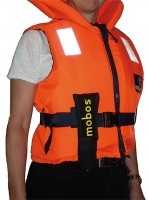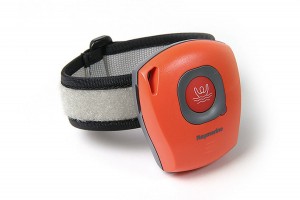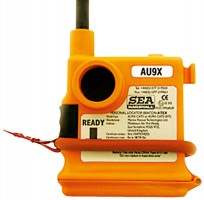A new player on the market is claiming to be the first in portable GPS-guided man overboard alarms
How do you recover a man overboard (MOB)? It’s all very well if you notice straight away and perform the prescribed Williamson turn in time but what if several seconds or minutes pass before you realise anyone is missing, not to mention if it occurs at night? In either of these scenarios the first problem is locating the MOB.
Seven years ago we tested several man overboard alarms to see how well they worked. It was a real eye-opener to discover just how hard it is to spot somebody who has fallen off the boat at 20 knots, even when you’re expecting it. At 30 knots the problem doubles. You don’t need to travel far before even small waves obscure a bobbing head.
In 2007 the MOB alarm system that impressed us most was a simple radio signal homing system from Sea Marshall. Since then, several MOB systems using AIS technology to track down the casualty have launched.
Now there’s a new player entering the fray with a fresh slant on the concept. The MOBOS (Man-Overboard-Operating-System) was shown at the Düsseldorf Boat Show by Seareq of Germany and claims to be the first portable GPS-guided MOB alarm. Unlike personal locator beacons or AIS-based systems, which send out a signal to the emergency services and/or other boats in the area, this one is designed to alert the skipper of the boat and guide them to the missing crew member. It is a development of Seareq’s ENOS (Electronic Rescue and Locating System), used by divers when they surface far from their boat. The divers activate a GPS beacon to let the skipper know they have surfaced and guide the dive boat to their location.
MOBOS uses the same technology but has the added advantage of an automatic trigger as well as a manual one. Each crew member wears a beacon, which is linked to an automatic, self-inflating lifejacket. When the beacon is triggered it sends a UHF (ultra-high frequency) alert signal to the on-board receiver. An alarm sounds immediately, while the beacon starts searching for a satellite signal. In most cases this will take around 40 seconds. Once the beacon gets a fix it transmits the position to the on-board receiver, which makes its calculations and guides you back to the MOB with a course to steer and an arrow indicating whether you need to turn to port or starboard. It will also give your boat’s position, the location of the MOB and the distance to travel.
Where this differs from rival systems is that it does not transmit its position as an AIS message or via the PLB emergency channel, so it’s not going to be any use if the whole boat sinks or there is no one left on board to effect a rescue. Critics will also argue that the Coastguard and vessels in the area should be alerted to any MOB situation regardless, even if in 99% of cases the vessel best placed to rescue the casualty is the one they fell off.
Seareq says the skipper can easily send a DSC Mayday, including precise details of the MOB’s location, if they are in any doubt about their ability to recover the casualty themselves.
MOBOS comes portable or fixed. The portable system is ideal for delivery skippers or owners of more than one boat. You can even transfer it to your tender if required. This also removes the problem of retrospectively fitting it to a dash already packed with electronics.
Although UHF transmissions do not have the range of VHF signals, they don’t require such a big antenna either. UHF also penetrates physical barriers better than VHF so locating the portable receiver inside a wheelhouse is not a problem. One downside is that UHF drains more power than VHF but given its use, this is unlikely to be a critical factor.
Each receiver can monitor multiple beacons so there is no practical limit to the number of crew it can cover.
The receiver costs £1,200 inc VAT and £480 for each beacon. This looks pretty steep compared to the cost of some PLBs but for blue-water sailors seeking the reassurance of a self-sufficient MOB system, it could prove a wise investment.
Contact www.seareq.de
MOB systems
Broadly speaking, these are the four types of man-overboard (MOB) systems – proximity alarms, DSC, AIS and 121.5MHz based systems, although some devices use a combination of the above.
1 Proximity alarms
These work by maintaining continual radio contact between the receiver and one or more crew fobs. If contact is lost the alarm is triggered, notifying the skipper of an MOB and marking the position of the boat on the chartplotter at that time.
Pros Simplicity, compact crew fobs, low cost.
Cons The MOB icon on the plotter only shows the position of the boat when the alarm was triggered, not the actual location of the person in the water. Strong winds, tides and poor visibility can still make it hard to locate the MOB.
Examples Raymarine LifeTag,
NASA MOBi
2 DSC systems
These are self-contained personal locator beacons which send an automated MOB Mayday alert and GPS position via the VHF Channel 70 Digital Selective Calling system to all vessels in the area including the host craft. The message is repeated on Channel 16 by an automated voice recording to ensure maximum coverage.
Pros Doesn’t rely on the host vessel rescuing the casualty; no special receiver required other than a VHF.
Cons Limited range of VHF signal; won’t automatically mark the MOB’s position on a chartplotter.
Example Sea
Marshall V100
3 AIS systems
These personal AIS beacons send a signal to all craft within a range of approximately four miles fitted
with AIS-enabled chartplotters.
Each beacon is equipped with its
own GPS locator so a fix can be made before transmitting a radio signal via the Automatic Identification System. Some of
these devices use a combination
of AIS and DSC to give improved coverage.
Pros Any craft within four miles equipped with an AIS plotter should receive the MOB alert and show
the casualty’s position on the chartplotter on board.
Cons Limited range; the signal is only visible to AIS-equipped craft.
Examples Marine Rescue Technologies sMRT V100, McMurdo Smartfind S10
and S20
4 121.5MHz systems
Unlike personal locator beacons, which send a message directly to the emergency services via the 406MHz global distress frequency, these MOB systems use the more localised 121.5MHz homing frequency to guide the mothership (and local emergency services) back to the casualty. Some systems use a combination of 121.5MHz and AIS to maximise coverage.
Pros Quicker and more reliable than a GPS fix, homing signals can be tracked by local rescue services as well as the mothership’s receiver.
Cons Needs a special base unit and homing antenna on board the host vessel to find the casualty.
Examples Marine Rescue Technologies Crewguard,
Sea Marshall SARfinder 1003
MOB locator
First published in Motor Boat & Yachting, issue April 2014.
Subscribe to the print version of MBY
Subscribe to a digital version of MBY















